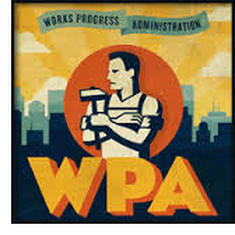THE WORKS PROGRESS ADMINISTRATION (WPA)

The Works Progress Administration (renamed in 1939 as the Work Projects Administration; WPA) was the largest and most ambitious American New Deal agency, employing millions of unemployed people (mostly unskilled men) to carry out public works projects, [ including the construction of public buildings and roads. In a much smaller but more famous project, the Federal Project Number One, the WPA employed musicians, artists, writers, actors and directors in large arts, drama, media, and literacy projects.
Almost every community in the United States had a new park, bridge or school constructed by the agency. The WPA's initial appropriation in 1935 was for $4.9 billion (about 6.7 percent of the 1935 GDP), and in total it spent $13.4 billion.
At its peak in 1938, it provided paid jobs for three million unemployed men and women, as well as youth in a separate division, the National Youth Administration. Headed by Harry Hopkins, the WPA provided jobs and income to the unemployed during the Great Depression in the United States. Between 1935 and 1943, the WPA provided almost eight million jobs. Full employment, which was reached in 1942 and emerged as a long-term national goal around 1944, was not the WPA goal. It tried to provide one paid job for all families in which the breadwinner suffered long-term unemployment. Robert D. Leighninger asserts that “The stated goal of public building programs was to end the depression or, at least, alleviate its worst effects. Millions of people needed subsistence incomes. Work relief was preferred over public assistance (the dole) because it maintained self-respect, reinforced the work ethic, and kept skills sharp."
The WPA was a national program that operated its own projects in cooperation with state and local governments, which provided 10–30% of the costs. Usually the local sponsor provided land and often trucks and supplies, with the WPA responsible for wages (and for the salaries of supervisors, who were not on relief). WPA sometimes took over state and local relief programs that had originated in the Reconstruction Finance Corporation (RFC) or Federal Emergency Relief Administration (FERA) programs.
It was liquidated on June 30, 1943, as a result of low unemployment due to the worker shortage of World War II. The WPA had provided millions of Americans with jobs for 8 years. Most people who needed a job were eligible for at least some of its positions. Hourly wages were typically set to the prevailing wages in each area.
The WPA built traditional infrastructure of the New Deal such as roads, bridges, schools, courthouses, hospitals, sidewalks, waterworks, and post-offices, but also constructed museums, swimming pools, parks, community centers, playgrounds, coliseums, markets, fairgrounds, tennis courts, zoos, botanical gardens, auditoriums, waterfronts, city halls, gyms, and university unions. Most of these are still in use today. The amount of infrastructure projects of the WPA included 40,000 new and 85,000 improved buildings. These new buildings included 5,900 new schools; 9,300 new auditoriums, gyms, and recreational buildings; 1,000 new libraries; 7,000 new dormitories; and 900 new armories. In addition, infrastructure projects included 2,302 stadiums, grandstands, and bleachers; 52 fairgrounds and rodeo grounds; 1,686 parks covering 75,152 acres; 3,185 playgrounds; 3,026 athletic fields; 805 swimming pools; 1,817 handball courts; 10,070 tennis courts; 2,261 horseshoe pits; 1,101 ice-skating areas; 138 outdoor theatres; 254 golf courses; and 65 ski jumps. Total expenditures on WPA projects through June 1941, totaled approximately $11.4 billion. Over $4 billion was spent on highway, road, and street projects; more than $1 billion on public buildings, including the iconic Dock Street Theater in Charleston, the Griffith Observatory in Los Angeles, and the Timberline Lodge on Oregon's Mt. Hood.
COPPELL HISTORICAL SOCIETY, P.O. BOX 1871, COPPELL, TX 75019
[email protected]
The Coppell Historical Society is a 501 (c)(3) non-profit organization